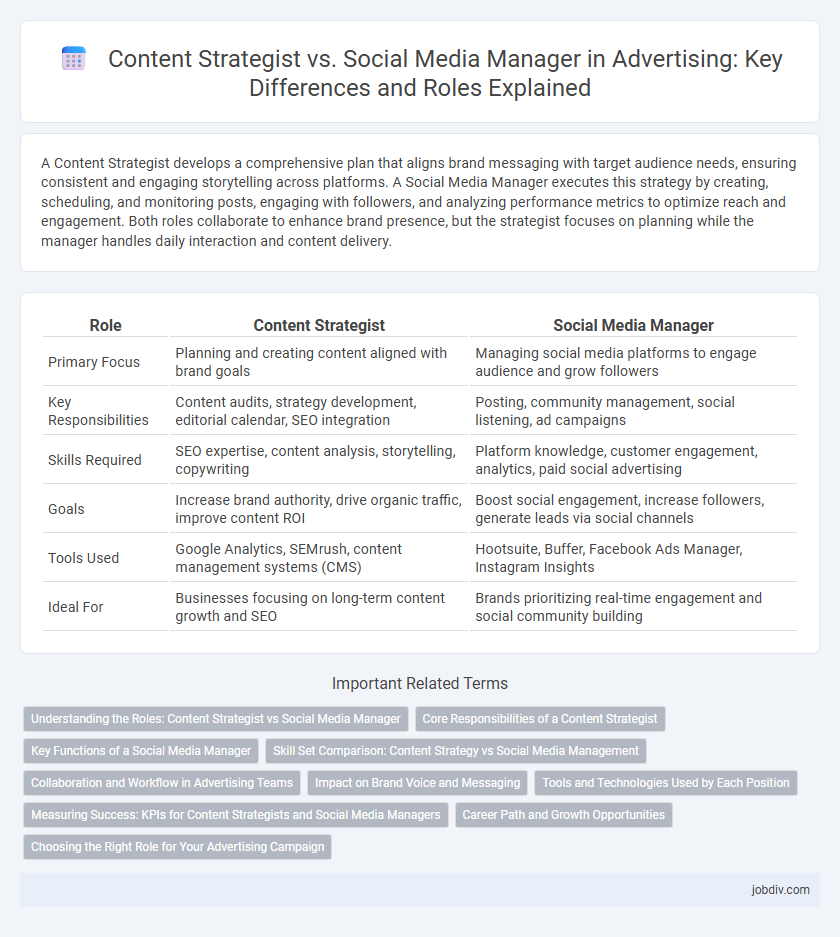A Content Strategist develops a comprehensive plan that aligns brand messaging with target audience needs, ensuring consistent and engaging storytelling across platforms. A Social Media Manager executes this strategy by creating, scheduling, and monitoring posts, engaging with followers, and analyzing performance metrics to optimize reach and engagement. Both roles collaborate to enhance brand presence, but the strategist focuses on planning while the manager handles daily interaction and content delivery.
Table of Comparison
| Role | Content Strategist | Social Media Manager |
|---|---|---|
| Primary Focus | Planning and creating content aligned with brand goals | Managing social media platforms to engage audience and grow followers |
| Key Responsibilities | Content audits, strategy development, editorial calendar, SEO integration | Posting, community management, social listening, ad campaigns |
| Skills Required | SEO expertise, content analysis, storytelling, copywriting | Platform knowledge, customer engagement, analytics, paid social advertising |
| Goals | Increase brand authority, drive organic traffic, improve content ROI | Boost social engagement, increase followers, generate leads via social channels |
| Tools Used | Google Analytics, SEMrush, content management systems (CMS) | Hootsuite, Buffer, Facebook Ads Manager, Instagram Insights |
| Ideal For | Businesses focusing on long-term content growth and SEO | Brands prioritizing real-time engagement and social community building |
Understanding the Roles: Content Strategist vs Social Media Manager
Content Strategists focus on creating comprehensive content plans that align with brand goals and target audience insights, ensuring consistent messaging across multiple channels. Social Media Managers execute these strategies by managing daily social media activities, engaging with the community, and analyzing platform-specific performance metrics. Understanding these roles clarifies how strategic planning integrates with operational execution to drive effective advertising campaigns.
Core Responsibilities of a Content Strategist
A Content Strategist develops comprehensive content plans by analyzing audience insights, market trends, and brand goals to create cohesive messaging across multiple platforms. They oversee content creation workflows, ensuring alignment with SEO best practices and brand voice consistency to maximize engagement and conversion rates. Their role involves ongoing performance analysis and strategic adjustments to optimize content effectiveness and support overall marketing objectives.
Key Functions of a Social Media Manager
A Social Media Manager is responsible for creating, scheduling, and monitoring content across various social platforms to drive engagement and brand awareness. They analyze social media metrics to optimize campaigns and respond to audience interactions in real-time. Collaboration with marketing teams ensures alignment with overall advertising goals and targeted messaging.
Skill Set Comparison: Content Strategy vs Social Media Management
A Content Strategist excels in planning, creating, and managing overall content to align with brand goals, emphasizing SEO, audience research, and editorial calendar development. A Social Media Manager specializes in platform-specific engagement, community management, real-time analytics interpretation, and crafting shareable posts tailored to diverse social channels. Both roles require strong communication and analytical skills, but the Content Strategist focuses on long-term content planning, while the Social Media Manager prioritizes immediate audience interaction and campaign execution.
Collaboration and Workflow in Advertising Teams
Content Strategists and Social Media Managers collaborate closely in advertising teams to ensure cohesive brand messaging and optimized audience engagement. Content Strategists develop data-driven plans and messaging frameworks that Social Media Managers implement through targeted campaigns and real-time community interactions. Streamlined workflow between these roles enhances campaign effectiveness, aligning creative content with platform-specific strategies for maximum reach and impact.
Impact on Brand Voice and Messaging
A Content Strategist shapes the brand voice by developing comprehensive messaging frameworks and long-term content plans that ensure consistency across all channels. A Social Media Manager implements these strategies in real-time, tailoring the brand's voice to engage specific social platforms and audience segments effectively. Together, their roles create a cohesive yet adaptable brand presence that strengthens audience connection and drives engagement.
Tools and Technologies Used by Each Position
Content Strategists utilize advanced analytics platforms like Google Analytics and SEMrush to optimize content performance, alongside project management tools such as Trello and Asana for workflow coordination. Social Media Managers rely heavily on scheduling and management tools like Hootsuite, Buffer, and Sprout Social to plan and monitor social campaigns in real-time. Both roles leverage graphic design software such as Canva or Adobe Creative Suite, but Social Media Managers often require more proficiency in community engagement tools like Facebook Insights and Twitter Analytics for audience interaction analysis.
Measuring Success: KPIs for Content Strategists and Social Media Managers
Content strategists measure success through KPIs such as content engagement rates, organic traffic growth, and conversion rates driven by targeted messaging. Social media managers focus on metrics like follower growth, post reach, click-through rates, and social media engagement to evaluate campaign effectiveness. Both roles rely on data analytics tools to optimize content delivery and audience interaction for maximizing ROI.
Career Path and Growth Opportunities
Content Strategists focus on long-term planning, brand messaging, and multi-channel content development, positioning themselves for roles in digital marketing leadership and creative direction. Social Media Managers specialize in real-time engagement, platform-specific campaigns, and community management, often advancing toward social media director or communications manager roles. Both career paths offer growth through developing data-driven strategies, cross-functional collaboration, and mastering emerging digital tools in the advertising industry.
Choosing the Right Role for Your Advertising Campaign
A Content Strategist develops comprehensive content plans aligned with brand goals, focusing on audience analysis, content creation, and distribution strategies to maximize campaign effectiveness. A Social Media Manager executes these strategies by managing platform-specific content, engaging with audiences, and analyzing social metrics to optimize performance. Choosing the right role depends on whether your campaign needs a visionary planner for long-term content direction or an agile executor for real-time social engagement and community building.
Content Strategist vs Social Media Manager Infographic

 jobdiv.com
jobdiv.com